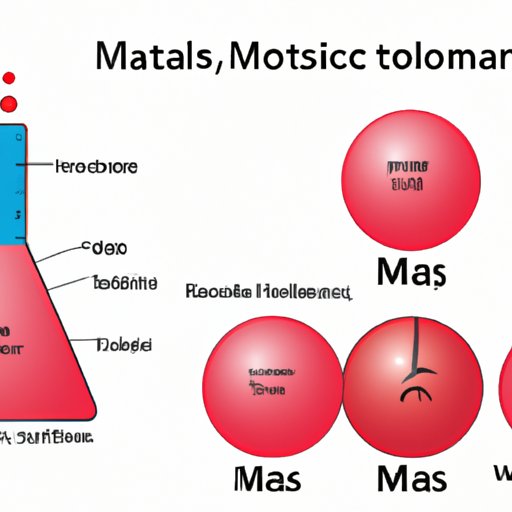How to Calculate Molar Mass: A Beginner’s Guide to Understanding Chemistry
Understanding molar mass is a crucial part of chemistry. Molar mass is defined as the mass of one mole of a substance, and it’s an essential component of many chemical equations. This article will provide a step-by-step guide on how to calculate molar mass, explain why it’s important in chemistry, and offer practical tips and tricks for simplifying the process.
A Step-by-Step Guide to Calculating Molar Mass for Beginners
The process of calculating molar mass can be broken down into simple steps. The first step is to determine the atomic mass of each element in a molecule or compound. This information can be found on the periodic table, where the atomic mass of an element is the weighted average of all of its isotopes.
Next, you need to add up the atomic masses of all the elements in the molecule or compound. This will give you the total molar mass, which is expressed in grams per mole.
For example, to calculate the molar mass of water (H2O), you first need to find the atomic masses of hydrogen and oxygen. The atomic mass of hydrogen is 1.008, and the atomic mass of oxygen is 15.999. To find the molar mass of one molecule of water, you add the atomic masses of two hydrogen atoms and one oxygen atom:
(2 x 1.008) + 15.999 = 18.015 g/mol
Therefore, the molar mass of water is 18.015 grams per mole.
Understanding the Importance of Molar Mass in Chemistry and How to Calculate It
Molar mass is essential in chemistry because it allows you to convert between the mass of a substance and the number of moles or particles it contains. This information is critical for performing stoichiometric calculations, which involve calculating the quantities of reactants and products in a chemical reaction.
Calculating molar mass using the periodic table is relatively straightforward. Every element on the periodic table has a unique atomic mass, which can be used to find the molar mass. The atomic mass of an element is listed below its symbol and represents the weighted average of all of its isotopes.
Once you have found the atomic masses of all the elements in a molecule or compound, you can add them up to find the total molar mass:
Molar Mass = Sum of Atomic Masses of All Elements in the Compound.
For example, consider the molar mass of carbon dioxide (CO2). Carbon has an atomic mass of 12.01, and oxygen has an atomic mass of 15.999. To calculate the molar mass of CO2, you add up the atomic masses of carbon and two oxygen atoms:
(1 x 12.01) + (2 x 15.999) = 44.01 g/mol
The molar mass of carbon dioxide is 44.01 grams per mole.
Explaining the Difference Between Atomic Mass and Molar Mass and How to Calculate Both
Atomic mass is the mass of an atom, while molar mass is the mass of one mole of a substance. Atomic mass is expressed in atomic mass units (amu), while molar mass is expressed in grams per mole.
Calculating atomic mass involves finding the sum of the masses of all the particles in an atom, including protons, neutrons, and electrons. However, calculating atomic mass is not essential in most chemical calculations.
On the other hand, molar mass is a critical component of many chemical calculations. Calculating molar mass involves finding the sum of the atomic masses of all the elements in a molecule or compound, as mentioned earlier.
Tips and Tricks for Simplifying the Process of Calculating Molar Mass
Calculating molar mass can be simplified by using several shortcuts and tricks. For example, the molar mass of a compound can be estimated by rounding the atomic masses to the nearest whole number.
Additionally, many common elements have molar masses that are multiples of 12, such as carbon (12.01 g/mol) and oxygen (16.00 g/mol). By memorizing these common molar masses, you can quickly estimate the molar mass of many compounds.
Practical Applications of Molar Mass Calculation in Real-World Chemistry Scenarios
Molar mass calculation has many practical applications in real-world chemistry scenarios. For example, it is used to calculate the amount of a reactant needed to produce a specific amount of product in a chemical reaction.
Molar mass calculation is also used to determine the amount of a substance present in a sample. This information is crucial for determining the purity of a substance, as well as for analyzing the contents of a sample.
Common Mistakes to Avoid When Calculating Molar Mass and How to Correct Them
One of the most common mistakes in calculating molar mass is forgetting to include all the elements in a compound or molecule. Make sure to include the atomic masses of all the elements present in the compound or molecule.
Another common mistake is failing to convert the atomic masses from atomic mass units (amu) to grams per mole. Always make sure to use the correct units when calculating molar mass.
Conclusion
Calculating molar mass is essential for many chemical calculations and has many real-world applications. It allows you to convert between mass and moles, which is critical for performing stoichiometric calculations. By following the step-by-step guide and tips outlined in this article, you can better understand and calculate molar mass in chemistry.
